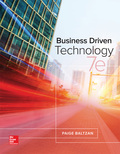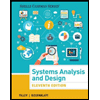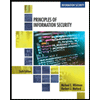
EBK BUSINESS DRIVEN TECHNOLOGY
7th Edition
ISBN: 8220103675451
Author: BALTZAN
Publisher: YUZU
expand_more
expand_more
format_list_bulleted
Concept explainers
Question
Chapter 14, Problem 7RQ
Program Plan Intro
Business Model:
- A business model is a company’s plan for how it will create, deliver, and generates revenue on the internet and make a profit.
- It lays out a step by step plan of action for profitable operation of a business in a specific marketplace.
- The term business model is used to represent the core aspects of business which include purpose, strategies, business process infrastructure, trading practices, etc.
- Business model is divided into mainly four categories as follows:
- Business-to-business (B2B)
- Business-to-Consumer (B2C)
- Consumer-to-business (C2B)
- Consumer-to-consumer (C2C)
Expert Solution & Answer
Want to see the full answer?
Check out a sample textbook solution
Students have asked these similar questions
Modular Program Structure. Analysis of Structured Programming Examples. Ways to Reduce Coupling.
Based on the given problem, create an algorithm and a block diagram, and write the program code:
Function: y=xsinx
Interval: [0,π]
Requirements:
Create a graph of the function.
Show the coordinates (x and y).
Choose your own scale and show it in the block diagram.
Create a block diagram based on the algorithm.
Write the program code in Python.
Requirements:
Each step in the block diagram must be clearly shown.
The graph of the function must be drawn and saved (in PNG format).
Write the code in a modular way (functions and the main part should be separate).
Please explain and describe the results in detail.
Based on the given problem, create an algorithm and a block diagram, and write the program code:
Function: y=xsinx
Interval: [0,π]
Requirements:
Create a graph of the function.
Show the coordinates (x and y).
Choose your own scale and show it in the block diagram.
Create a block diagram based on the algorithm.
Write the program code in Python.
Requirements:
Each step in the block diagram must be clearly shown.
The graph of the function must be drawn and saved (in PNG format).
Write the code in a modular way (functions and the main part should be separate).
Please explain and describe the results in detail.
Based on the given problem, create an algorithm and a block diagram, and write the program code:
Function: y=xsinx
Interval: [0,π]
Requirements:
Create a graph of the function.
Show the coordinates (x and y).
Choose your own scale and show it in the block diagram.
Create a block diagram based on the algorithm.
Write the program code in Python.
Requirements:
Each step in the block diagram must be clearly shown.
The graph of the function must be drawn and saved (in PNG format).
Write the code in a modular way (functions and the main part should be separate).
Please explain and describe the results in detail.
Chapter 14 Solutions
EBK BUSINESS DRIVEN TECHNOLOGY
Knowledge Booster
Learn more about
Need a deep-dive on the concept behind this application? Look no further. Learn more about this topic, computer-science and related others by exploring similar questions and additional content below.Similar questions
- Question: Based on the given problem, create an algorithm and a block diagram, and write the program code: Function: y=xsinx Interval: [0,π] Requirements: Create a graph of the function. Show the coordinates (x and y). Choose your own scale and show it in the block diagram. Create a block diagram based on the algorithm. Write the program code in Python. Requirements: Each step in the block diagram must be clearly shown. The graph of the function must be drawn and saved (in PNG format). Write the code in a modular way (functions and the main part should be separate). Please explain and describe the results in detail.arrow_forward23:12 Chegg content://org.teleg + 5G 5G 80% New question A feed of 60 mol% methanol in water at 1 atm is to be separated by dislation into a liquid distilate containing 98 mol% methanol and a bottom containing 96 mol% water. Enthalpy and equilibrium data for the mixture at 1 atm are given in Table Q2 below. Ask an expert (a) Devise a procedure, using the enthalpy-concentration diagram, to determine the minimum number of equilibrium trays for the condition of total reflux and the required separation. Show individual equilibrium trays using the the lines. Comment on why the value is Independent of the food condition. Recent My stuff Mol% MeOH, Saturated vapour Table Q2 Methanol-water vapour liquid equilibrium and enthalpy data for 1 atm Enthalpy above C˚C Equilibrium dala Mol% MeOH in Saturated liquid TC kJ mol T. "Chk kot) Liquid T, "C 0.0 100.0 48.195 100.0 7.536 0.0 0.0 100.0 5.0 90.9 47,730 928 7,141 2.0 13.4 96.4 Perks 10.0 97.7 47,311 87.7 8,862 4.0 23.0 93.5 16.0 96.2 46,892 84.4…arrow_forwardYou are working with a database table that contains customer data. The table includes columns about customer location such as city, state, and country. You want to retrieve the first 3 letters of each country name. You decide to use the SUBSTR function to retrieve the first 3 letters of each country name, and use the AS command to store the result in a new column called new_country. You write the SQL query below. Add a statement to your SQL query that will retrieve the first 3 letters of each country name and store the result in a new column as new_country.arrow_forward
- We are considering the RSA encryption scheme. The involved numbers are small, so the communication is insecure. Alice's public key (n,public_key) is (247,7). A code breaker manages to factories 247 = 13 x 19 Determine Alice's secret key. To solve the problem, you need not use the extended Euclid algorithm, but you may assume that her private key is one of the following numbers 31,35,55,59,77,89.arrow_forwardConsider the following Turing Machine (TM). Does the TM halt if it begins on the empty tape? If it halts, after how many steps? Does the TM halt if it begins on a tape that contains a single letter A followed by blanks? Justify your answer.arrow_forwardPllleasassseee ssiiirrrr soolveee thissssss questionnnnnnnarrow_forward
- 4. def modify_data(x, my_list): X = X + 1 my_list.append(x) print(f"Inside the function: x = {x}, my_list = {my_list}") num = 5 numbers = [1, 2, 3] modify_data(num, numbers) print(f"Outside the function: num = {num}, my_list = {numbers}") Classe Classe that lin Thus, A pro is ref inter Ever dict The The output: Inside the function:? Outside the function:?arrow_forwardpython Tasks 5 • Task 1: Building a Library Management system. Write a Book class and a function to filter books by publication year. • Task 2: Create a Person class with name and age attributes, and calculate the average age of a list of people Task 3: Building a Movie Collection system. Each movie has a title, a genre, and a rating. Write a function to filter movies based on a minimum rating. ⚫ Task 4: Find Young Animals. Create an Animal class with name, species, and age attributes, and track the animals' ages to know which ones are still young. • Task 5(homework): In a store's inventory system, you want to apply discounts to products and filter those with prices above a specified amount. 27/04/1446arrow_forwardOf the five primary components of an information system (hardware, software, data, people, process), which do you think is the most important to the success of a business organization? Part A - Define each primary component of the information system. Part B - Include your perspective on why your selection is most important. Part C - Provide an example from your personal experience to support your answer.arrow_forward
arrow_back_ios
SEE MORE QUESTIONS
arrow_forward_ios
Recommended textbooks for you
 Systems ArchitectureComputer ScienceISBN:9781305080195Author:Stephen D. BurdPublisher:Cengage Learning
Systems ArchitectureComputer ScienceISBN:9781305080195Author:Stephen D. BurdPublisher:Cengage Learning Principles of Information Systems (MindTap Course...Computer ScienceISBN:9781305971776Author:Ralph Stair, George ReynoldsPublisher:Cengage Learning
Principles of Information Systems (MindTap Course...Computer ScienceISBN:9781305971776Author:Ralph Stair, George ReynoldsPublisher:Cengage Learning Systems Analysis and Design (Shelly Cashman Serie...Computer ScienceISBN:9781305494602Author:Scott Tilley, Harry J. RosenblattPublisher:Cengage Learning
Systems Analysis and Design (Shelly Cashman Serie...Computer ScienceISBN:9781305494602Author:Scott Tilley, Harry J. RosenblattPublisher:Cengage Learning
 Principles of Information Security (MindTap Cours...Computer ScienceISBN:9781337102063Author:Michael E. Whitman, Herbert J. MattordPublisher:Cengage Learning
Principles of Information Security (MindTap Cours...Computer ScienceISBN:9781337102063Author:Michael E. Whitman, Herbert J. MattordPublisher:Cengage Learning

Systems Architecture
Computer Science
ISBN:9781305080195
Author:Stephen D. Burd
Publisher:Cengage Learning

Principles of Information Systems (MindTap Course...
Computer Science
ISBN:9781305971776
Author:Ralph Stair, George Reynolds
Publisher:Cengage Learning

Systems Analysis and Design (Shelly Cashman Serie...
Computer Science
ISBN:9781305494602
Author:Scott Tilley, Harry J. Rosenblatt
Publisher:Cengage Learning



Principles of Information Security (MindTap Cours...
Computer Science
ISBN:9781337102063
Author:Michael E. Whitman, Herbert J. Mattord
Publisher:Cengage Learning